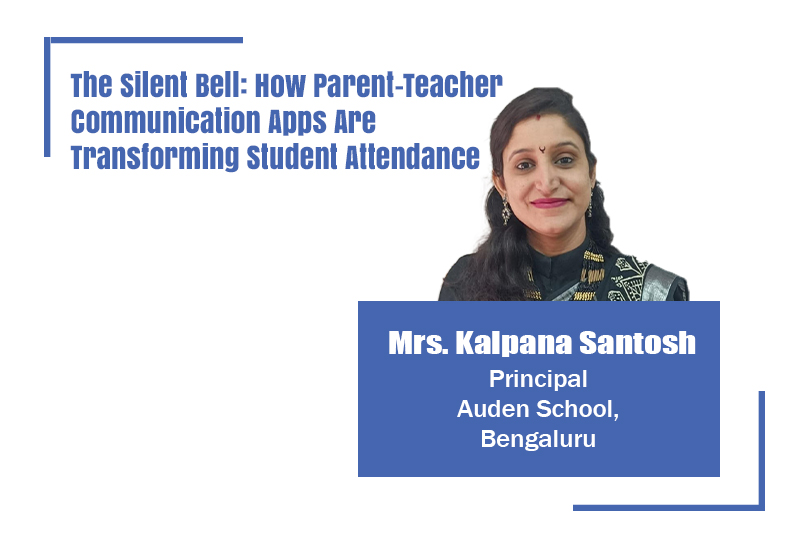The Silent Bell: How Parent-Teacher Communication Apps Are Transforming Student Attendance
Mrs. Kalpana Santosh
Principal, Auden School
In the ever-evolving educational landscape, the familiar ringing of the school bell is no longer the only sound guiding students into classrooms. Today, the subtle digital chime of a parent-teacher communication app often plays a more decisive role in ensuring consistent attendance. What was once seen as a passive statistic in a school’s data sheet has become an actively managed and technology-driven priority.
At the forefront of this transformation is Mrs. Kalpana Santosh, Principal of Auden School. She strongly believes that digital communication platforms are reshaping the way educators and parents collaborate. In her perspective, attendance is no longer just a number—it is a reflection of student engagement, accountability, and school-home partnership.
The Attendance Problem, Reimagined
For decades, absenteeism has been viewed as a stubborn challenge in schools. Chronic absenteeism is more than just a missed roll call; it translates into lost learning opportunities, widened academic achievement gaps, and long-term disengagement from education.
Mrs. Santosh stresses that traditional methods such as reminder letters, follow-up phone calls, or disciplinary warnings have limited impact in reversing absenteeism trends. In her words, the fundamental shift occurs when attendance is addressed proactively rather than reactively.
From her standpoint, parent-teacher communication apps such as ClassDojo, Remind, and Schoology are revolutionizing this approach. Instead of waiting for patterns of absenteeism to become severe, schools can now intervene immediately, reshaping the narrative around attendance from one of punishment to one of partnership.
Real-Time Alerts, Real-World Impact
A key benefit that Mrs. Santosh highlights is the real-time functionality of these apps. She points out that when a student is marked absent, an instant notification is sent to the parent’s phone. There is no delay, confusion, or guesswork involved.
In her view, this immediacy strengthens the home-school feedback loop. Parents can quickly confirm whether the absence was intentional, unintentional, or due to genuine concerns like health or transportation issues. Conversely, teachers gain clarity and reassurance that attendance records are being communicated instantly and transparently.
As she explains, when a parent knows what is happening in real time, the chances of quick action and intervention rise dramatically.
Beyond Notifications: Building Accountability and Trust
Mrs. Santosh emphasizes that these apps are not just about notifications but about building stronger, more trusting relationships. Unlike one-sided communication methods, parent-teacher apps provide two-way channels, enabling parents to respond, ask questions, or seek clarification.
From her perspective, this mutual engagement fosters accountability among students. Children realize that parents and teachers are aligned and closely monitor their progress. In her words, when students feel that their presence—or absence—does not go unnoticed, it naturally motivates them to take attendance seriously.
Moreover, these platforms enable teachers to share attendance patterns, highlight progress, and celebrate improvements. Acknowledging even small milestones, such as a student reducing absenteeism significantly, reinforces positive behavior and motivates continued effort.
Personalized Interventions Made Possible
One of the aspects Mrs. Santosh finds most impactful is the data-driven personalization offered by parent-teacher communication apps. These platforms don’t just record attendance; they create comprehensive visualizations of trends and patterns.
For instance, she notes that schools can identify if a student is frequently absent on specific days, which might point to external issues like transportation or family commitments. Similarly, schools can track whether improved attendance correlates with increased parent engagement or teacher outreach.
In her opinion, this transformation marks a shift from reactive punishment to proactive problem-solving. Rather than penalizing absenteeism, educators can now address its root causes—offering academic support, counseling, or logistical assistance.
The Role of Digital Education Tools in Student Engagement
Mrs. Santosh also underscores the broader role of digital education tools in improving student attendance. She observes that apps like ClassDojo, Remind, and Schoology track attendance and integrate features that encourage student engagement.
Students feel more motivated to attend regularly through gamified rewards, positive reinforcement, and classroom updates. As she puts it, when education feels interactive and rewarding, the desire to show up increases naturally.
Additionally, these apps allow parents to remain connected beyond attendance updates. They can access homework reminders, progress reports, and teacher feedback—all of which contribute to a more holistic view of the child’s academic journey.
The Future: AI and Predictive Support
Looking ahead, Mrs. Santosh is particularly enthusiastic about integrating Artificial Intelligence (AI) and predictive analytics into these platforms. She believes the next wave of innovation will enable apps to identify risks before absenteeism becomes a chronic issue.
She imagines scenarios where an app could flag early warning signs—such as declining grades, unusual attendance gaps, or even shifts in the emotional tone of student-teacher messages. With these insights, parents and teachers could step in early, preventing disengagement before it escalates into prolonged absenteeism.
In her assessment, such advancements will improve attendance and contribute to better emotional and academic well-being for students.
Why Attendance Tracking Matters More Than Ever
To reinforce her perspective, Mrs. Santosh outlines several reasons why attendance tracking through digital tools is now indispensable:
- Bridging Gaps Quickly: Immediate alerts ensure that no absence goes unnoticed.
- Building Parent-Teacher Trust: Transparent communication strengthens school-home relationships.
- Creating Student Accountability: Students realize that their presence is consistently monitored.
- Data-Driven Decisions: Patterns help educators identify problems early and create effective interventions.
- Enhanced Student Engagement: Integrated learning tools make attending school more appealing.
She maintains that schools risk losing students to disengagement and indifference without such proactive systems.
Rewriting the Attendance Narrative
In conclusion, Mrs. Kalpana Santosh firmly believes that parent-teacher communication apps are rewriting the story of school attendance. For her, it is no longer merely recording who is present or absent; it is about ensuring every student feels valued, noticed, and supported.
She argues that when schools remove the barriers between parents and teachers, attendance becomes a shared mission rather than an isolated responsibility. In a world where every single day of learning counts, digital education tools act as safeguards, ensuring fewer students slip through the cracks.






